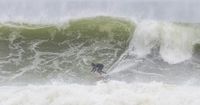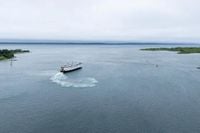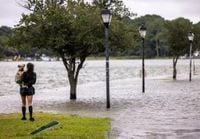On August 21 and 22, 2025, Nantucket and Martha’s Vineyard found themselves at the mercy of Hurricane Erin, a massive Atlantic storm whose power was felt up and down the East Coast. The hurricane, which had fluctuated in strength since forming near the Cape Verde islands over a week earlier, brought with it a rare blend of awe and anxiety. While the storm’s eye remained hundreds of miles offshore, its effects were impossible to ignore—from the pounding surf and dangerous rip currents to the winds that rattled windows and nerves alike.
According to the Associated Press, Hurricane Erin had weakened to a Category 1 hurricane by early Friday, August 22, with maximum sustained winds of 90 mph (150 kph). The National Hurricane Center in Miami reported the storm’s center was about 425 miles south-southwest of Halifax, Nova Scotia. Despite its drop in intensity, Erin remained a force to be reckoned with, stretching over 600 miles—twice the size of an average hurricane. This immense wind field meant that even as the core of the storm stayed far offshore, coastal communities from the Carolinas to New England were battered by strong winds and waves.
For Nantucket, the storm’s impact was immediate and dramatic. As reported by Nantucket Current, Hurricane Erin kicked up a massive swell that brought overhead waves to the island’s beaches—conditions that local surfers dream about but rarely see. Cisco and Madequecham beaches became the stage for a handful of the island’s best surfers, who braved the rough seas to ride waves that towered above them. Photographer Chris Tran was on hand to capture these rare moments, immortalizing the thrill and danger of surfing during a hurricane.
Yet for most residents and visitors, caution was the order of the day. All south shore beaches on Nantucket were closed to swimming due to the large surf and dangerous rip currents, as reported by WCVB Channel 5. The waves at Cisco Beach were described as “double what we usually see,” by Kerry Shriver of Hingham, who marveled at the power of the ocean. Eric Rosenbrger of Duxbury echoed this sentiment: “These seem pretty rough, living where we do, coastal, up on the south shore. Sometimes, there’s some pretty big waves, but these are pretty impressive.”
Beach erosion was another immediate consequence. “Kind of sad seeing the beach a little washed up, but hopefully, it comes back in a couple weeks,” said Mario Rinaldi, a Nantucket local. Rinaldi also remarked, “Definitely the biggest waves I’ve seen here ever. Really crazy.” The dangerous rip currents, experts warned, were expected to linger even after the storm moved away from the area.
Elsewhere along the coast, similar stories played out. On North Carolina’s Outer Banks, waves breached dunes in Kill Devil Hills on Thursday evening, and water and sand pooled on Highway 12. The Outer Banks, essentially sand dunes sticking out of the ocean just a few feet above sea level, are particularly vulnerable to erosion and storm surges. But as Dare County Manager Bobby Outten told the Associated Press, there was relief in the aftermath: “All in all it’s not as bad as it could have been. Hopefully the worst of it is behind us.” No new inlets formed, and there was no significant structural damage to homes or businesses—a lucky break for a region that’s seen its share of hurricane devastation.
Still, the spectacle of nature’s fury drew onlookers. At Jennette’s Pier in Nags Head, North Carolina, sustained winds reached 45 mph (72 kph), and dozens of people gathered to watch huge waves crash into the pier amid driving rain. David Alan Harvey, a Nags Head resident, summed up the feeling for many: “This is nature at her best. I love this. I love these storms.”
Further north, coastal flood warnings were issued for the Mid-Atlantic and New England coasts, with the National Weather Service cautioning that some roads could become impassable. Beaches in New York City were closed to swimming on August 21, but that didn’t stop a determined group of surfers from riding the hurricane-fueled waves at Rockaway Beach. Scott Klossner, a local surfer, told the Associated Press, “You wait all year round for these kinds of waves. It’s challenging, really hard to stay in one place, because there’s a heavy, heavy, heavy rip. But this is what surfers want—a hurricane that comes but doesn’t destroy my house? I’ll take that.”
In Massachusetts, the effects of Erin rippled beyond Nantucket. Westport closed its beaches, including the popular Horseneck Beach, to swimming. Normally bustling with swimmers, boogie boarders, and surfers, the beach was marked with double red flags—no swimming allowed. Still, a few surfers couldn’t resist the call of the waves. “It’s awesome,” said Owen Koss, a surfer who took the risk. “We haven’t seen swell like this in a while. It’s refreshing. Feels good to get out there.”
Transportation was also disrupted. The MBTA canceled ferry service for Winthrop, Lynn, and Quincy, and the Hy-Line canceled service for Martha’s Vineyard and inter-island routes. The Steamship Authority diverted service for Oak Bluffs to Vineyard Haven and waived change and cancellation fees for all travel scheduled for Friday, acknowledging the unpredictability of the storm’s impact.
Hurricane Erin’s journey was a textbook example of a Cape Verde hurricane—one that forms near the islands off Africa’s west coast and traverses thousands of miles of warm ocean before threatening North America. These storms are often among the most dangerous, and Erin’s sheer size and persistent strength made it a formidable presence even as it stayed offshore. According to the Associated Press, Erin managed to “thread the needle” between the East Coast and several island nations, sparing the mainland from the worst-case scenario but still reminding everyone of the ocean’s power.
Perhaps the most iconic image of Erin’s passage was that of 21-year-old surfer Robbie Goodwin riding a huge wave off Nantucket Island, captured on August 21. As reported by the New York Post, the moment was a testament to the allure and danger of hurricanes for surfers—a fleeting opportunity to experience waves of a lifetime, set against the backdrop of a community holding its breath.
As the storm moved farther out to sea, the immediate danger began to subside, but the memory of Erin’s wild surf and howling winds lingered on Nantucket and beyond. For some, it was a reminder of the ocean’s unpredictability; for others, a rare thrill. Either way, Hurricane Erin left its mark—not in destruction, but in awe and respect for the forces that shape the coastline year after year.


